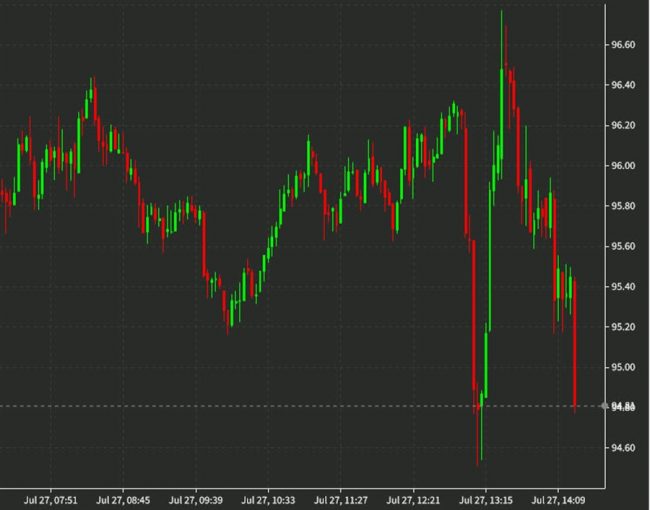- Prior crude -446K
- Gasoline -3304 vs -857K expected
- Distillates -748 vs +500K expected
- Cushing +751K
- Refinery utilization -1.5%
- US implied oil demand (product supplied) fell by 1.049 mbpd
- Implied motor gasoline demand 9.25mbpd vs 8.52mbpd last week
The SPR drew by another 5604K barrels, which continues to run shy of the 1 mbpd target.
The API numbers from late yesterday
- Crude -4037K
- Gasoline +1060K
- Distillates -550K
Crude oil
Crude Oil
Crude oil is the most popular tradable instrument in the energy sector, offering exposure to global market conditions, geopolitical risk, and economics. The instrument is strategically relied upon and situated in the global economy. Crude oil has proven to be a unique option for traders given volatility and the efficacy of both swing trading and longer-term strategies. Despite its popularity, crude oil is a very complex investing instrument, given the litany of fluctuations in oil prices, risk, and impact of politics stemming from OPEC. Short for the Organization of the Petroleum Exporting Countries, OPEC operates as an intergovernmental organization of 13 countries, helping set and dictate the global oil market.How to Trade Crude Oil Crude oil is most commonly traded as an exchange-traded fund (ETF) or through other instruments with exposure to it. This includes energy stocks, the USD/CAD, and other investing options. Crude oil itself is traded across a duality of markets, including the West Texas Intermediate Crude (WTI) and Brent crude. Brent is the more relied upon index in recent years, while WTI is more heavily traded across futures trading at the time of writing. Other than geopolitical events or decisions by OPEC, crude oil can move due to a variety of different ways. The most basic is through simple supply and demand, which is affected by global output. Increased industrial output, economic prosperity, and other factors all play a role in crude prices. By extension, recessions, lockdowns, or other stifling factors can also influence crude prices. For example, an oversupply or mitigated demand due to the aforementioned factors would result in lower crude prices. This is due to traders selling crude oil futures or other instruments. Should demand rise or production plateau, traders will bid increasingly on crude, whereby driving prices up.
Crude oil is the most popular tradable instrument in the energy sector, offering exposure to global market conditions, geopolitical risk, and economics. The instrument is strategically relied upon and situated in the global economy. Crude oil has proven to be a unique option for traders given volatility and the efficacy of both swing trading and longer-term strategies. Despite its popularity, crude oil is a very complex investing instrument, given the litany of fluctuations in oil prices, risk, and impact of politics stemming from OPEC. Short for the Organization of the Petroleum Exporting Countries, OPEC operates as an intergovernmental organization of 13 countries, helping set and dictate the global oil market.How to Trade Crude Oil Crude oil is most commonly traded as an exchange-traded fund (ETF) or through other instruments with exposure to it. This includes energy stocks, the USD/CAD, and other investing options. Crude oil itself is traded across a duality of markets, including the West Texas Intermediate Crude (WTI) and Brent crude. Brent is the more relied upon index in recent years, while WTI is more heavily traded across futures trading at the time of writing. Other than geopolitical events or decisions by OPEC, crude oil can move due to a variety of different ways. The most basic is through simple supply and demand, which is affected by global output. Increased industrial output, economic prosperity, and other factors all play a role in crude prices. By extension, recessions, lockdowns, or other stifling factors can also influence crude prices. For example, an oversupply or mitigated demand due to the aforementioned factors would result in lower crude prices. This is due to traders selling crude oil futures or other instruments. Should demand rise or production plateau, traders will bid increasingly on crude, whereby driving prices up.
Read this Term softened ahead of the release:
Crude has traded around $95.40 in the aftermath. That’s a surprising draw but the implied demand numbers continue to run soft, which is very strange given that we’re in the summer driving season. There was a bounce in gasoline demand this week but not quite as strong as the bulls would hope given how poor the past two weeks were and how gasoline prices have fallen.
Another notable details is that US crude oil exports hit a record 4.55 million barrels per day (h/t @priapusIQ). With the brent-WTI spread at nearly $10, that will remain high.
www.forexlive.com
